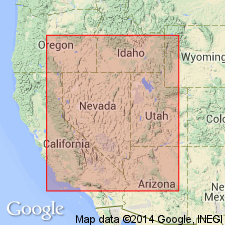
- Usage in publication:
-
- Portage Canyon Member
- Modifications:
-
- Named
- Dominant lithology:
-
- Dolostone
- AAPG geologic province:
-
- Wasatch uplift
- Great Basin province
Summary:
Named as member (fourth from base, of six members) of Laketown Dolostone (redescribed). Type section is in West Hills near mouth of Portage Canyon, for which unit is probably named, T14N, R4W, northeastern Box Elder Co, UT [detailed description of type section not given]. Outcrops at numerous mountain ranges in western UT and eastern NV, Wasatch uplift and Great Basin province. Consists of brownish-black to medium-dark-gray dolostone; microcrystalline to finely crystalline; some parts are very finely laminated; weathers medium dark gray to medium light gray. Deposited in subtidal, low-energy environment. Average thickness is 160 ft. Overlies Gettel or High Lake Members (both new), of Laketown; underlies Jack Valley or Decathon Member (both revised) of Laketown, or underlies Water Canyon Formation. Measured sections. Silurian age [basis of age not discussed].
Source: GNU records (USGS DDS-6; Denver GNULEX).
For more information, please contact Nancy Stamm, Geologic Names Committee Secretary.
Asterisk (*) indicates published by U.S. Geological Survey authors.
"No current usage" (†) implies that a name has been abandoned or has fallen into disuse. Former usage and, if known, replacement name given in parentheses ( ).
Slash (/) indicates name conflicts with nomenclatural guidelines (CSN, 1933; ACSN, 1961, 1970; NACSN, 1983, 2005, 2021). May be explained within brackets ([ ]).

